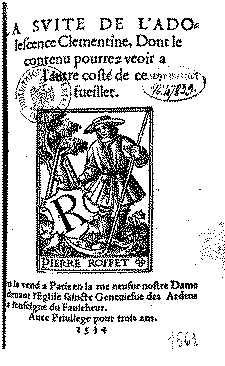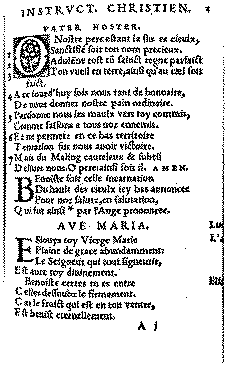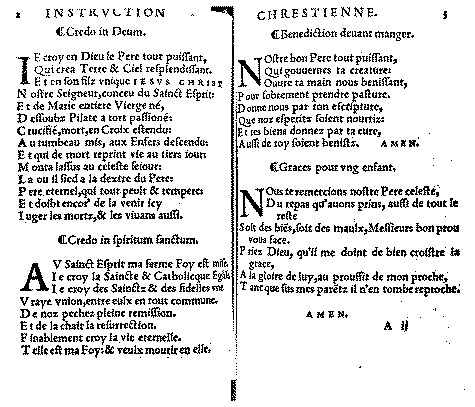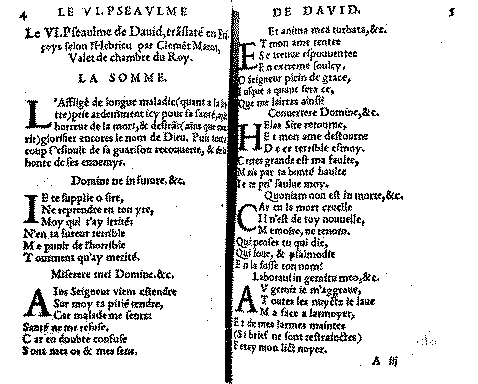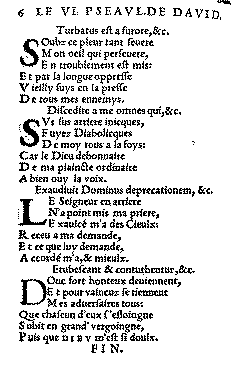|
|
||||||||||||||||||||||||||||||||||||||||||||||||||||||||||||||||||||||||||||||||||||||||||||||||||||||||||||||||||||||||||||||||||||||||||||||||||||||||||||||||||||||||||||||||||||||||||||||||||||||||||||||||||||||||||||||||||||||||||||||||||||||||||||||||||||||||||||||||||||||||
|
Note on the ‘liturgical extras’ (French poems by Clément Marot)Canticle of Simeon, Decalogue, Creed, Ave Maria, Pater Noster and prayers before and after dinner. (for texts click 'up')
In 1533 (a kind of Evangelical Wonder Year in France with the King’s Sister Marguerite in charge in Paris and the Lenten sermons of Gérard Roussel in the Louvre) Clément Marot started to supply the Evangelical movement with some basic religious texts in the vernacular. The first specimen appeared in a Lyonnese reprint of the first collection Marot’s poetical Works (L’Adolescence clementine)> The first - official -edition had appeared in Paris in 1532 and was a huge success. François Juste, a Lyonnese printer, also published this popular book on 23 February 1533 and added some extra material: a verse translation of the Lord’s Prayer and the Creed (in two parts) "Les Articles de la Foy", introduced by the publisher as Le Pater noster, et le Credo en francoys faict et traduict par ledict. C.M. et offert na guyeres a la Royne de Navarre.[1] This edition was not ‘officially’ supervised by Marot. To these two fundamental texts Juste added a prayer before dinner, Benediction devant manger (“Nostre bon Pere tout puissant”) in a reissue of L'Adolescence clementine at 12 July 1533, the ensemble now being introduced as Foy d’ung chrestien.[2] Marot’s authorship is only established for the Creed and the Lord’s Prayer, since he himself included them in later editons. The prandial prayer he never republished although in clandestine editions they were retained. Quite a common practice in the 16th century, resulting in insolvable questions about authorship. For the 16th century reader they were Marot’s. This prayer was put to music by Crispel. About the same time the same prayers (Creed, Lord’s Prayers, Benediction) appeared in print as the last part of a curious amalgam of Evangelical epistles dealing with prayer, published in Paris by Antoine Augereau: Epistre familiere de prier Dieu. Aultre epistre familiere d’aymer chrestiennement, followed by a tract dealing with the proper way to write French: Briefve doctrine pour deuement escripre selon la propriete du langaige francoys. The the title of the prayer section in this publication is L’Instruction et Foy ung Chrestien. [3] Still in 1533 the same printer, Antoine Augereau, (re-)issued Marguerite’s devotional book: Miroir de l’ame pecheresse three times, first anonymously, afterwards openly and in an expanded version with Marot’s verse translation of Psalm 6 at the end (for the first time in de second Augereau print of 1533. At the same time, he reissued the mixed treatise about prayer and orthography not only expanding the orthographic tract but also adding two new prayers to the Instruction: a French translation of the ‘Ave Maria, La Salutation Angelique", the Angelic Greeting (“Esjouys toy Vierge Marie”)[4] and a Graces pour ung enfant; a postprandial prayer (“Nous te remercions nostre Pere celeste”). This edition of the Epistres–Doctrine–Instruction appeared in December 1533. It was reprinted shortly afterwards .[5] This substantial production and publication of devotional texts reveals that Marot in 1533 was actively involved in the Evangelical movement around Marguerite d’Alençon (later to become Queen of Navarre).
Enlarged with Psalm 6, the Instruction et Foy d'ung chrestien" (1533) was integrated in the second edition of La Suite de l'Adolescence clementine, even figuring prominently at its beginning (Paris, Veuve P. Roffet, 1534; Mayer n° 17). It got a title: Instruction Chrestienne. Since it is not sure whether Marot really authorized this edition, there is no conclusive evidence of authorship:
All poems but one, the Benediction devant manger (“Nostre bon Pere tout puissant”) are incorporated in Les Oraisons, the section that concludes the 1538 edition of Marot’s Oeuvres (Lyon, Dolet/Grypius; Mayer n° 70/71). This authenticates all prayers, except the Benediction devant manger.[6]
In the edition of the Cinquante Pseaulmes by Roffet in Paris (1543), the Lord’s Prayer, the Creed and the Angelic Salutation have been included with only slight changes; all Latin incipits are preceded by French titles. Two new prandial prayers (before and after dinner) replace their predecessors of L’Instruction (and consequently La Suite): O souverain Pasteur et Maistre and Père Eternel, qui nous ordonnes. Also new are poetical paraphrases of the Canticle of Simeon, Or laisses, Createur[7]. To this the Genevan edition of the the Cinquante Pseaumes of 1543 (Jean Girard) adds a rhymed version of the Ten Commandments: Lève le Coeur, ouvre l'oreille.
From then on these extra’s become part and parcel of the hymnbook (or book of common prayer) of the Reforming Churches, issu de Calvin. First often with melodies, but gradually only as texts for private devotion. The Ten Commandments and the Canticle of Simeon became part of the liturgical order, so they kept their tunes. Two Schemes to summarize and get an overview:
In Hymnbooks (small selection)Apart from the Canticle of Simeon and the Decalogue, melodies are not always present and not always the same. For precise info: consult Pidoux, Psautier Huguenot I (melody nrs: 201-207). From 1562 the Geneva editions still keep the Creed, the Lord’s Prayer, and the two prandial prayers, but without melodies.
[1] L’Adolescence clementine of 23 February 1533 (Mayer n° 13; Rothschild n° 597). By older bibliographers this edition is erroneously dated 1534 (ancient style). [2] Mayer n° 14bis (12 July 1533). Helga Tichy, librarian of the Bayerische Staatsbibliothek (only extant copy), confirmed the presence of these three prayers with their heading in the Juste edition of 12 July 1533. An unfortunate circumstance is that in French Vernacular Books the editor seems to have been ignorant of this state of affairs and reintroduced Picot’s dating (FB 36594); the same mistake in FB 36613. [3] Mayer n° 241, n° 241bis (addenda), Higman F42–F44 (three editions in 1533, the last ‘Mense Decembri,’ correct chronological order: F43, F44, F42). The first edition (F43) contains the same prayers as the Juste edition of July. The Instruction et Foy d’ung Chrestien is not announced on the title page of this curious publication; it simply appears at the end. For the complex bibliographical matter, see Jeanne Veyrin–Forrer, ‘Antoine Augereau, graveur de lettres et imprimeur parisien (vers 1485?–1534),’ in La Lettre et le texte (Paris, 1987), pp. 3–50; an analysis of the Briefve doctrine on pp. 27–30, description of the editions on pp. 45–6 (nrs. 18–20). The content of L’instruction is summed up in Mayer Bibliographie, pp. 95–6. See also William Kemp, ‘Marguerite of Navarre, Clément Marot, and the Augereau Editions of the Miroir,’ Journal of the Early Book Society for the study of Manuscripts and Printing History 2 (1999), 113–56, in particular 116–7. [4] The text of this protestant Ave Maria only covers the first part of the classical Ave Maria, i.e., the salutation (Gabriel's Greeting) and the benediction (by Elisabeth), but not the invocation of Mary (‘ora pro nobis’). Dogmatically this prayer was acceptable to the reform–oriented Evangelicals in France (as can be deduced from its presence in the Instruction et Foy of 1533), but probably not to some of the more radical reformers or refugees living in Geneva. This explains why is had to be suppressed in 1543, when Calvin proposed the Genevan hymnbook based on Marot's Psalms and the liturgical and devotional prayers. [5] Higman F44 and F42 (Veyrin–Forrer, 19 and 20). The latter is a corrected reprint of the former, the changes mainly concerning the Briefve Doctrine. In two copies the third edition of the Miroir is bound in with the final editions of Epistres familières --Briefve Doctrine -- Instruction (F42, F44). This is more than incidental, since the last edition of the orthographic tract refers to examples in the Miroir, using very precise textual references. See the study by Veyrin–Forrer and Ph. Renouard, Imprimeurs et libraires parisiens du XVIe siècle, vol 1 (Paris, 1964), pp. 213–8 (n° 557–63). The presence of Marot’s Psalm 6 in the Miroir should not be linked to the fact that the faculty of theology forwarded the Miroir for censorship to the Parlement (October 1533), since it is highly likely that this concerned the first – anonymous – Augereau edition of the Miroir (M36), hence without Marot’s Psalm paraphrase. See W. Kemp, ‘Marguerite of Navarre, Clément Marot, and the Augereau Editions of the Miroir,’ p. 126. [6] Whether this omission is sufficient reason to deny the authorship of Marot, as done expressis verbis by Mayer (introduction to vol. 6 [Les traductions], p. 38), and tacitly by Defaux (who cites this prayer only in a note (Defaux I, p. 812)), is questionable. Omitting a poem in 1538 does not necessarily imply that Marot is not the author. A similar observation in Annie Coeurdevey, Bibliographie des oeuvres poétiques de Clément Marot mises en musique dans les recueils profanes du XVIe siècle (Paris, 1997), p. xvii. Guillaume Berthon also doubts the authenticity, based on text-internal evidence: the poem is metrically imperfect in a way not found by Marot since his firstlings. [7] De facto this canticle (Nunc dimittis) is tacitly introduced as the 50th Psalm in Les Cinquante Pseaulmes, since there are only 49 Psalms, to which this canticle as added at the end. [8] Only E1 and E2 read :"O nostre Père estant là hault es cieulx." [9] PA43 en GE43 give as title: La salutation angélique. GE43 has "Resjoy toy". In E1 and E2 the title is followed by: "Benoiste soit celle incarnation / Du hault des cieulx icy bas annoncée / Pour nos salutz, en salutation, / qui fut ainse par L'ange prononcée." also the biblical references are present and the 'speakers' is identified (Elisabeth and the Angel). The reference "Luc I II" and "Ave gratia, Dominus te" is placed below the title in PA43 (Mayer, Traductions, p. 105.) This is taken over when the Instruction was incorporated – as is , i.e. including the title... – in La Suite (2nd edition).. 1534. It disappears in 1538. (but reappears partly in PA43) [10] GE42 has the ‘old reading’, as in the ‘Instruction de foy’: O nostre pere estant la hault ..’ [11] In the Strasbourg edition the Creed (not versified) is printed with music, i.e. to be sung. In GE42 the text of Marot is introduced, including the separation in two parts as in the early text editions (Je croy en Dieu le pere & Au saint Esprit ma ferme foy). [12] The texts with asterisks are not by Marot. The Creed is a simple translation of the Credo into the vernacular, the Canticle of Simeon (Maintenant, Seigneur Dieu) and the Ten Commandments (Oyons la loy).
|
||||||||||||||||||||||||||||||||||||||||||||||||||||||||||||||||||||||||||||||||||||||||||||||||||||||||||||||||||||||||||||||||||||||||||||||||||||||||||||||||||||||||||||||||||||||||||||||||||||||||||||||||||||||||||||||||||||||||||||||||||||||||||||||||||||||||||||||||||||||||

